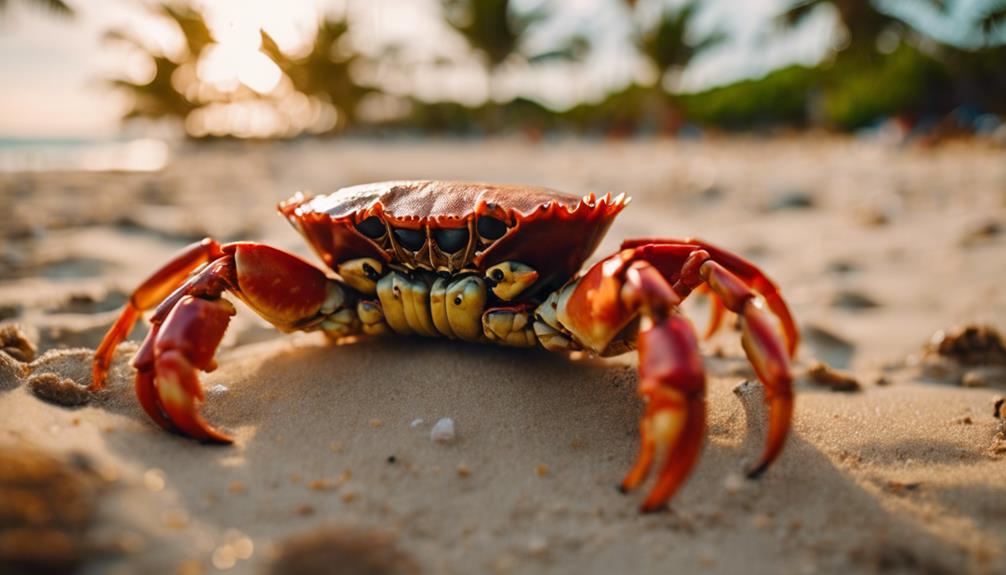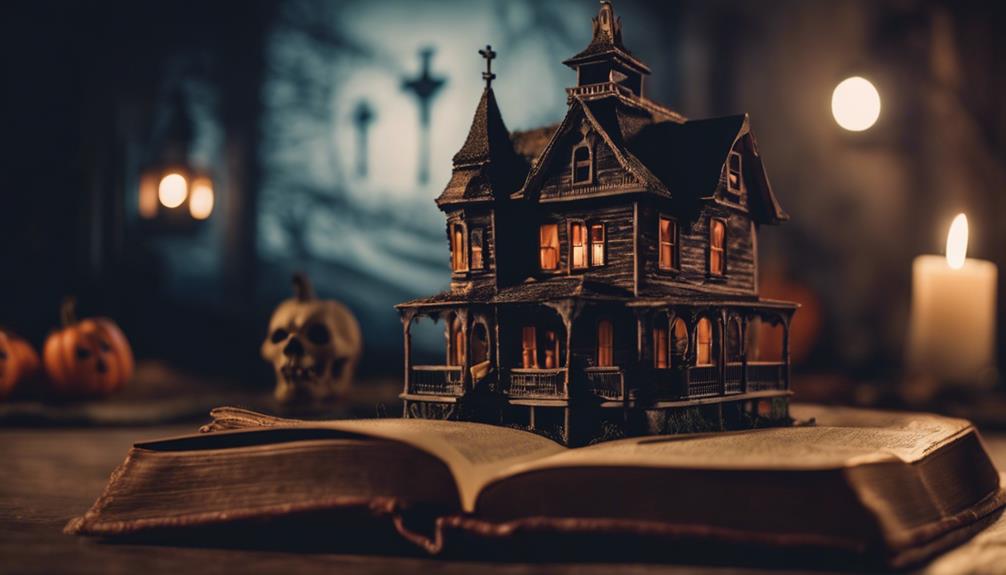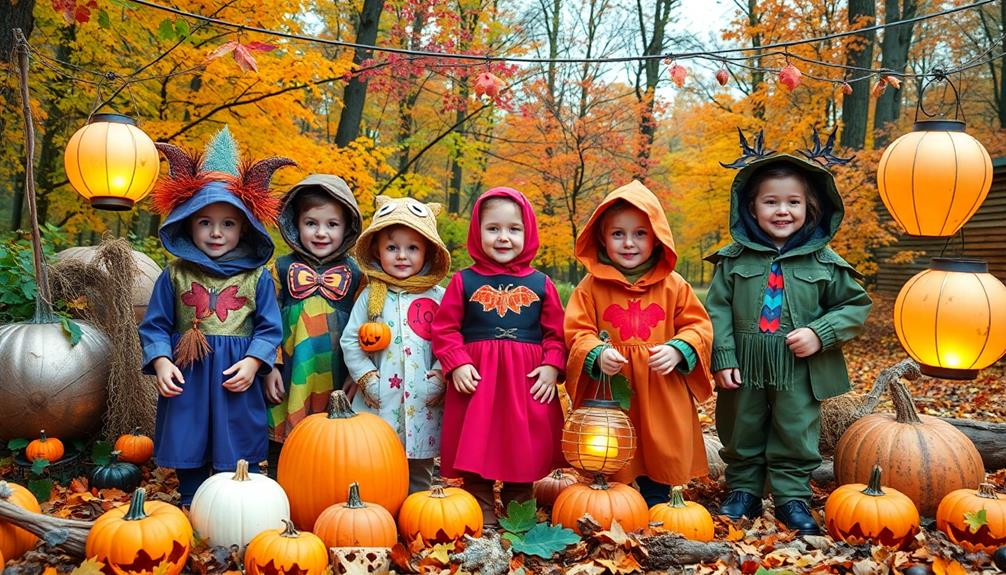Halloween crabs live in coastal areas along the Pacific coast of Costa Rica. They make their homes in mangroves, sand dunes, and coastal forests. These crabs, with their striking colors of orange, black, purple, blue, and white, are essential for the ecosystem. Their burrowing behaviors contribute to nutrient cycling and soil fertility, while also providing shelter and protection. If you're curious to learn more about these fascinating creatures and their habitats, discover how they interact with the environment in tropical forests and coastal areas, influencing plant populations and adding to the enchanting allure of their unique habitat.
Key Takeaways
- Halloween crabs live in coastal areas along the Pacific coast of Costa Rica.
- They thrive in mangroves, sand dunes, and coastal forests.
- These crabs start their journey in the ocean before migrating to lush forests.
- They prefer habitats with a balanced mix of land and water environments.
- Halloween crabs are commonly found in countries like Costa Rica, Mexico, and Panama.
Native Habitat of Halloween Crabs
In the coastal areas along the Pacific coast of Costa Rica is where you can find the native habitat of Halloween crabs, also known as Gecarcinus quadratus. These vibrant crabs thrive in a variety of habitats, including mangroves, sand dunes, and coastal forests of Costa Rica. As young crabs, they start their journey in the ocean before eventually migrating to the lush forests and mangroves that line the coastline.
The forests of Costa Rica provide the Halloween crabs with the perfect environment to burrow and create habitats for themselves and other species. Their striking colors of orange, black, purple, blue, and white make them stand out against the green backdrop of the forest floor. Not only are these crabs visually captivating, but they also play a vital role as ecosystem engineers, shaping the landscape through their burrowing activities.
Tropical Forests of Central America
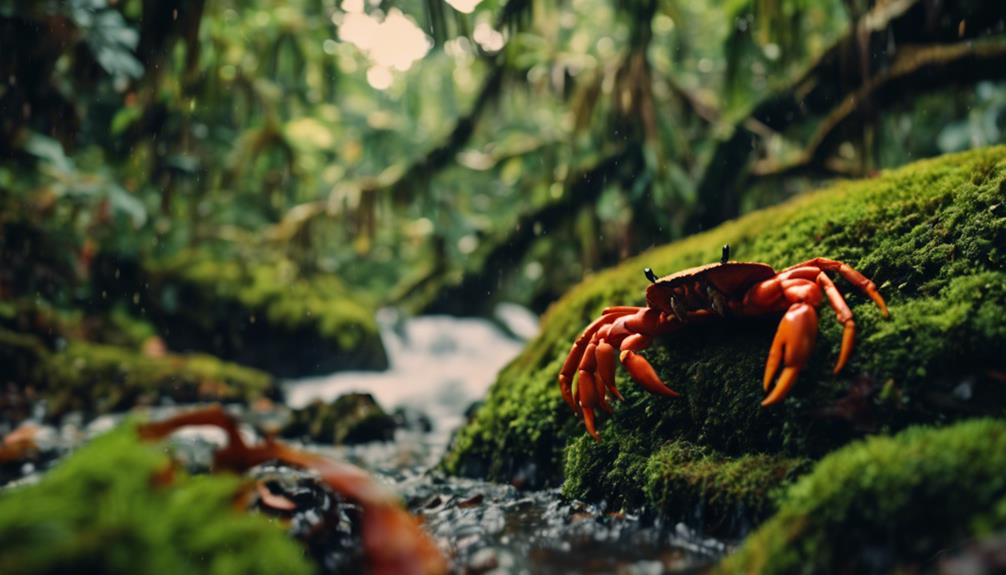
Exploring the lush tropical forests of Central America reveals a vital ecosystem where Halloween crabs, known scientifically as Gecarcinus quadratus, thrive alongside a diverse array of flora and fauna.
These vibrant crabs mainly inhabit the tropical forests along the Pacific coast of Central America, favoring countries like Costa Rica, Mexico, and Panama. Within these verdant landscapes, Halloween crabs find ideal habitats in mangrove swamps, sandy dunes, and rainforests.
Their presence in these tropical forests plays an essential role in the local ecosystem by contributing to nutrient cycling and habitat creation. The interaction of Halloween crabs with their environment influences plant populations and provides a source of food for various wildlife species in Central America.
As we venture through the dense foliage and vibrant biodiversity of Central America's tropical forests, the sight of these colorful crabs scurrying among the trees and undergrowth adds to the enchanting allure of this unique habitat.
Shoreline Burrows and Mangrove Swamps
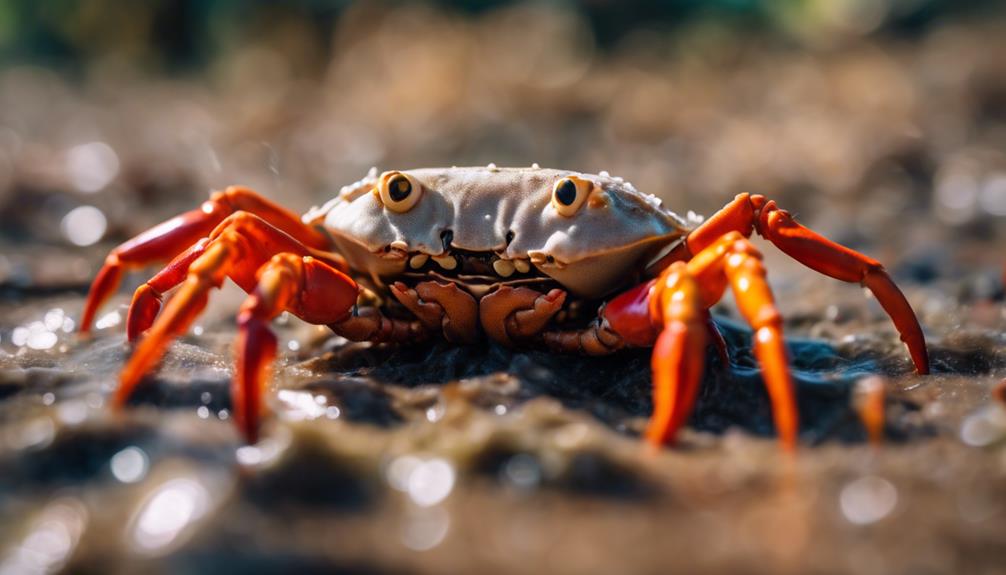
Exploring through the coastal landscapes of Central America, we observe Halloween crabs thriving in shoreline burrows and mangrove swamps. These crabs, scientifically known as Gecarcinus quadratus, are commonly found in these coastal areas along the Pacific coast of countries like Costa Rica, Mexico, and Panama. They prefer sandy soils near the water's edge, where they dig deep burrows up to five feet long. These burrows not only serve as shelters for the crabs but also provide essential protection from predators in the diverse coastal ecosystems they inhabit.
| Characteristics | Importance |
|---|---|
| Shoreline burrows | Provide shelter and protection for Halloween crabs |
| Mangrove swamps | Crucial habitats for nutrient cycling and ecosystem engineering |
| Coastal areas | Diverse ecosystems where Halloween crabs thrive |
Halloween crabs play an important role in maintaining the health of their shoreline and mangrove habitats through their activities. Their presence contributes significantly to the overall balance of these coastal ecosystems.
Ideal Conditions for Halloween Crabs
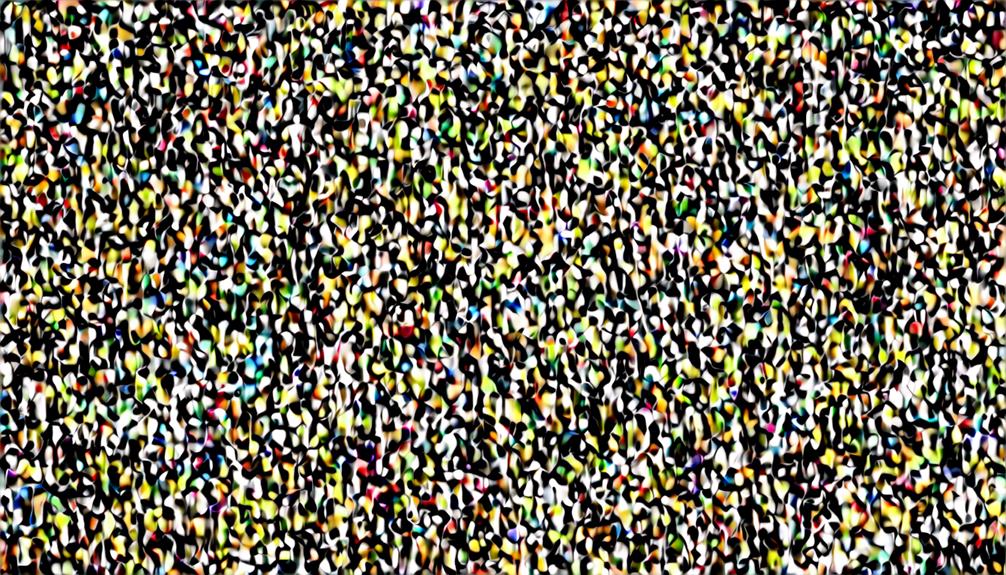
Halloween crabs require a balanced mix of land and water environments to thrive. They seek out areas with the right humidity levels, suitable substrates for burrowing, and access to food sources like leaf litter.
Providing essential living conditions is vital to guarantee the well-being of these colorful crabs in their natural habitats.
Habitat Requirements
When creating habitats for Halloween crabs, here are some key factors that should be taken into account:
- Moisture Levels: Halloween crabs prefer habitats with moderate moisture levels to keep their gills moist and facilitate breathing.
- Temperature Range: They thrive in environments with temperatures ranging from 75°F to 85°F, providing the ideal conditions for their metabolic processes.
- Substrate Type: Halloween crabs need soft substrates like sand or soil to facilitate burrowing and creating their intricate underground homes.
- Vegetation Cover: Coastal areas with abundant vegetation offer Halloween crabs ample food sources and shelter, supporting their foraging habits and overall well-being.
- Proximity to Water: Halloween crabs thrive in habitats that offer a balance between land and water, allowing them to move between these environments easily for feeding and breeding.
Suitable Environments
Thriving in coastal habitats with a mix of land and water, Halloween crabs exhibit a preference for sandy soils conducive to burrowing and creating extensive underground homes. These crabs can be found in various coastal areas such as mangroves, sand dunes, and rainforests along the Pacific coast from Mexico to Panama.
They're adept at moving between terrestrial and aquatic environments, making coastal rainforests in countries like Mexico, Costa Rica, Panama, and Nicaragua ideal habitats for them. The sandy substrates in these areas provide the perfect conditions for Halloween crabs to dig deep burrows, some reaching lengths of up to 1.5 meters.
The proximity to both land and water in these coastal regions allows for easy access to breeding and foraging activities. Overall, the forested coastal areas along the Pacific coast provide the ideal environment for Halloween crabs to thrive and carry out their daily activities.
Optimal Living Conditions
Our observations reveal that these fascinating creatures, the Halloween crabs, require specific conditions to flourish in their natural coastal habitats. To thrive, Halloween crabs need:
- Live in forests: Halloween crabs are most commonly found in coastal rainforests, mangroves, and sandy dunes along the Pacific coast of Central America. These forested areas provide the crabs with ample shelter and protection.
- Access to water: These crabs prefer habitats that offer a mix of land and water, allowing them easy access to both forested regions and tidal zones. The proximity to water sources is essential for their survival and breeding activities.
- Shelter: Halloween crabs are known to dig deep burrows in sandy soils near their preferred coastal habitats. These burrows provide them with shelter from predators and harsh environmental conditions.
- Food sources: Their natural habitat offers a variety of food sources like decaying plant matter, fruits, and small invertebrates, ensuring a balanced diet for the crabs.
- Breeding and molting conditions: The coastal regions where Halloween crabs reside provide the necessary conditions for breeding and molting, essential aspects of their life cycle.
Digging and Burrowing Behavior
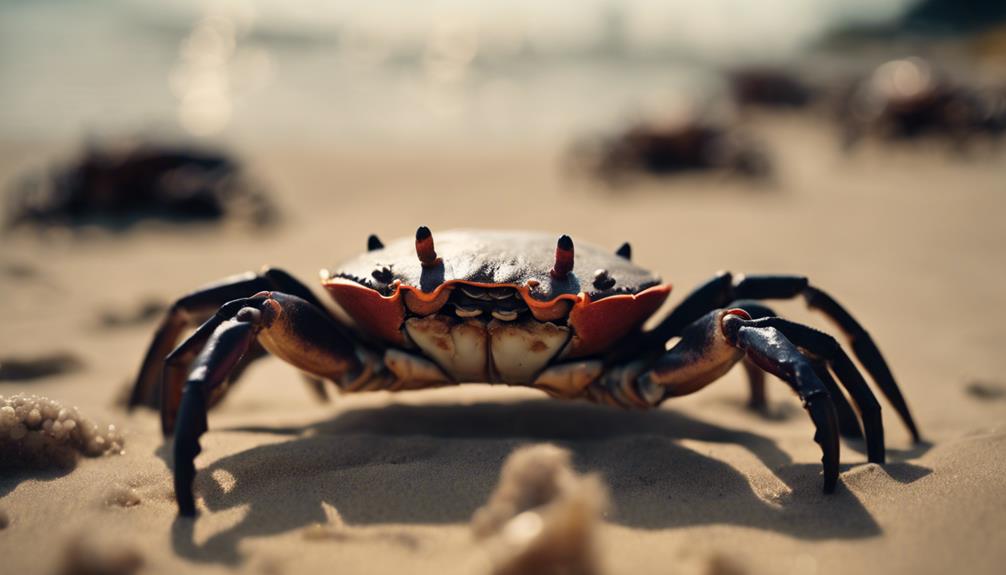
Halloween crabs are fascinating creatures known for their burrowing habits. They dig underground tunnels up to 1.5m long, using this behavior as a way to find shelter and create nests.
This digging behavior plays a vital role in their survival and contributes to the overall ecosystem dynamics.
Burrowing Habits of Halloween Crabs
In their natural habitat, Halloween crabs exhibit remarkable digging and burrowing behavior, creating intricate tunnels up to 1.5m long in sandy soils. This behavior is important for their survival in coastal forests, where they can find shelter and protection from predators.
Here are some key points about the burrowing habits of Halloween crabs:
- Halloween crabs are nocturnal creatures, actively digging their burrows during the night to avoid the heat of the day.
- These crabs use their specialized claws to excavate the sandy soils, creating extensive tunnel systems underground.
- The burrows serve as a safe retreat for the crabs, where they can rest, molt, and seek refuge from harsh weather conditions.
- By burrowing deep into the ground, Halloween crabs also help aerate the soil, benefiting the overall ecosystem of the coastal forests.
- Their burrowing activities play an essential role in nutrient cycling, as they bring organic matter into the soil, contributing to its fertility and health.
Digging Behavior for Shelter
After showcasing their remarkable burrowing habits, the digging behavior of Halloween crabs for shelter becomes a vital survival strategy in their coastal forest habitat. These crabs, found along the Pacific coast from Mexico to Panama, exhibit a unique trait of digging deep burrows, sometimes reaching lengths of up to 1.5 meters.
Their nocturnal nature drives them to create these intricate burrows to seek shelter during the day. Halloween crabs prefer habitats with sandy soils that allow for easy digging and burrowing, showcasing their adaptability to their environment.
The digging behavior of these crabs isn't just a random activity but serves as an essential aspect of their habitat selection and overall survival in the wild. By understanding the significance of their digging behavior for shelter, we gain insight into the resourcefulness and adaptation of Halloween crabs to their coastal forest homes.
Underground Tunnels and Nests
Creating extensive networks of underground tunnels and nests, Halloween crabs exhibit remarkable digging and burrowing behavior in their sandy coastal forest habitat. These behaviors are essential for their survival and ecosystem health. Here are some key points about their burrowing behavior in the coastal rainforest:
- Halloween crabs can dig burrows up to 1.5 meters long in the sandy soils, providing them with shelter and protection.
- The burrows serve as safe havens where the crabs rest and seek refuge from predators in the dynamic coastal ecosystem.
- Burrowing behavior is vital for their survival, allowing them to evade threats and maintain their well-being.
- By digging deep tunnels, Halloween crabs contribute to soil aeration, promoting healthier soil conditions in the coastal rainforest.
- Their burrowing activities also aid in nutrient cycling, influencing the overall ecosystem balance and functioning.
Significance of High Humidity
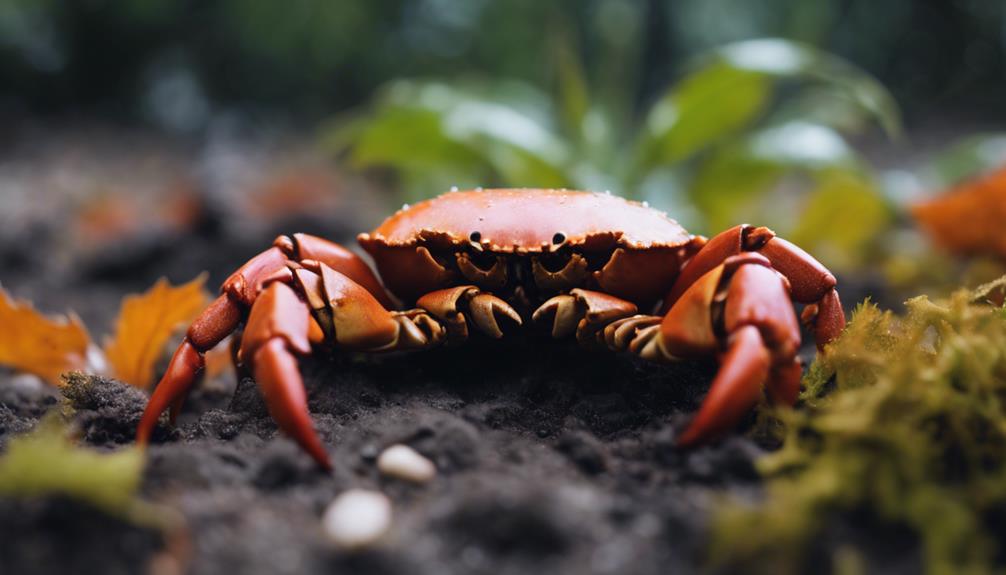
Maintaining ideal humidity levels in the habitat of Halloween crabs is vital for their health and well-being. These crabs originate from coastal areas like mangroves and rainforests, where high humidity prevails. Ensuring humidity levels around 70-80% in their enclosure is essential to prevent dehydration, support proper respiratory function, and facilitate their burrowing behavior. Halloween crabs thrive in moist environments, requiring a balance between land and water areas within their habitat. Inadequate humidity can lead to stress, respiratory issues, and other health problems for these creatures. Providing a humid environment that mimics their natural habitat is fundamental for the successful care of Halloween crabs.
| Importance of High Humidity for Halloween Crabs |
|---|
| Prevents dehydration and supports respiratory function |
| Facilitates burrowing behavior and overall well-being |
| Helps prevent stress, respiratory issues, and health problems |
| Vital for successful care and mimicking natural habitat |
Soft Substrate in Natural Habitats
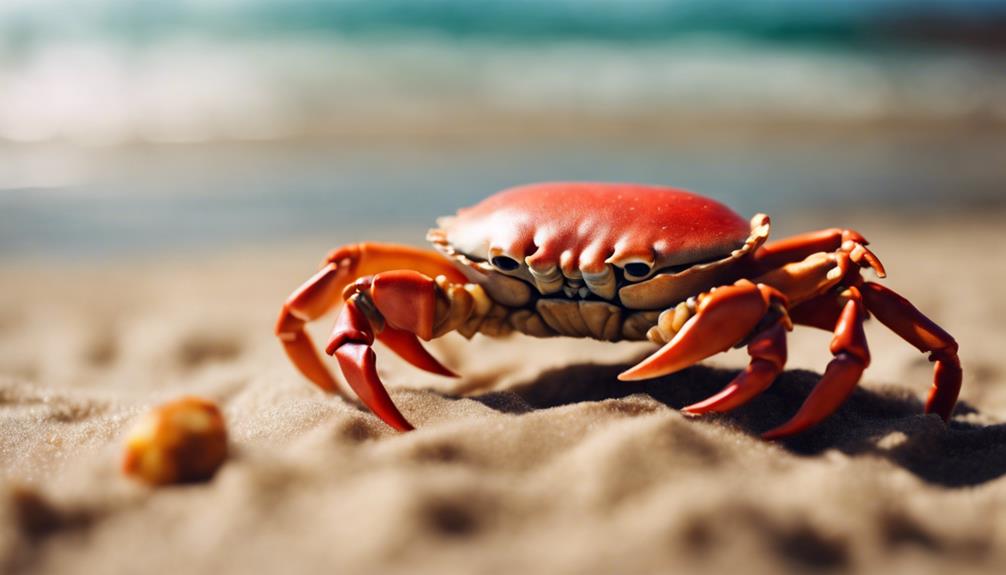
To understand the habitat requirements of Halloween crabs, it's essential to consider the importance of the soft substrate in their natural environments. Halloween crabs (Gecarcinus quadratus) thrive in habitats with soft substrates such as sand dunes, mangroves, and coastal rainforests. In these areas, they can dig deep burrows up to five feet long for shelter, showcasing their burrowing behavior. The soft substrate plays a critical role in enabling Halloween crabs to engage in various activities such as seeking protection, nesting, and thermoregulation. Additionally, the soft substrate supports their ecosystem engineering activities and contributes to the nutrient cycle in coastal environments.
- Soft substrates like sand dunes and mangroves provide Halloween crabs with ideal habitats for burrowing.
- Burrowing behavior in soft substrates allows Halloween crabs to create shelter and protection.
- Halloween crabs use the soft substrate for nesting purposes.
- Soft substrates aid in thermoregulation for Halloween crabs in their natural habitats.
- The ecosystem engineering activities of Halloween crabs are supported by the soft substrate, contributing to the nutrient cycle in coastal environments.
Frequently Asked Questions
Where in the World Do Halloween Crabs Live?
We can find Halloween crabs, scientifically known as Gecarcinus quadratus, along the Pacific coast of Costa Rica. These colorful creatures inhabit various coastal habitats like mangroves, sand dunes, and rainforests.
Stretching from Mexico to Panama, Halloween crabs have a broad geographic range. They're adaptable, venturing far from the water's edge, and play crucial roles in the ecosystems of the regions they occupy.
Do Halloween Moon Crabs Live in Water?
We don't typically find Halloween moon crabs living in water as adults. These crabs start off in the ocean, but as they mature, they move to coastal forests and mangroves. They can dig deep burrows in sandy soils far from the water's edge.
Halloween crabs are amazing ecosystem engineers, modifying habitats and providing homes for other creatures. By consuming seeds, seedlings, and leaf matter, they play a crucial role in the nutrient cycle.
Are Halloween Crabs Endangered?
Halloween crabs aren't currently endangered. They're classified as Least Concern on the conservation status scale, with a stable population. These crabs are commonly found in coastal areas, mangroves, sand dunes, and rainforests along the Pacific coast from Mexico to Panama.
While they play an important role in their ecosystems, their habitat isn't currently under significant threat. Conservation efforts focus on protecting their natural habitats and promoting sustainable practices in coastal regions.
What Is the Biome of a Halloween Crab?
We'll explore the biome of a Halloween crab. These fascinating creatures inhabit coastal regions, sand dunes, and lush rainforests along the Pacific coast from Mexico to Panama.
Their presence as ecosystem engineers leaves a mark, with burrows up to 1.5m long in sandy soils. Halloween crabs are nocturnal, residing in forests as adults, but their unique breeding behavior leads them back to the ocean.
Herbs, leaf litter, and seedlings make up their herbivorous diet.
Conclusion
As we conclude our investigation into where Halloween crabs reside, we've uncovered some intriguing details about their natural habitats in tropical forests and shoreline burrows.
But there's one more mystery to solve – the secret underground world of these elusive creatures.
Join us next time as we explore further into the hidden lives of Halloween crabs and discover even more surprises in their mysterious homes.
Stay tuned for more exciting discoveries!
